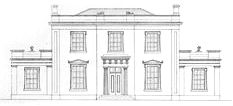Longbourn House is the principal building in Longbourn Village, Hertfordshire and is the home of Mr. Bennet and his family, including Mrs. Bennet, Jane, Elizabeth, Mary, Kitty, and Lydia. It is also the estate that Rev. William Collins will inherit upon the death of Mr. Bennet.
Architecture and Decor
We have limited information about the architecture or scale of Longbourn. We know the house has a formal vestibule, as scenes take place in it. Mr. Bennet, we’re told, spends a great deal of time in his library and can typically be found in there in the evenings. Mrs. Bennet, we know, has a dedicated dressing room, suggesting at least some grandeur in the appropriations of the master suite. The narrator tells us that Mary’s instrument is kept upstairs, suggesting there’s either a sitting room up there or more than one instrument. It’s unclear whether any of the Bennet girls share a bedroom with each other.
Park, Gardens and Land
As Mr. Bennet does discuss horses being needed in the fields, Longbourn must be attached to at least some farmed land. Historically, it is likely that Longbourn village is primarily composed of individuals who farm estate lands.
Staffing
Mrs. Bennet relies on constant assistance from Hill the housekeeper and the narrator does speak of an unnamed butler who tells Jane and Lizzy where to find their father when the settlement letter for Lydia arrives from Mr. Gardiner. As Mrs. Bennetis affronted at the notion of her daughters helping in the kitchen, there is certainly a cook and quite possibly a scullery maid, given the scale of entertaining the Bennets seem to do. We also know there are two housemaids, as Lydia shows off her ring to them, and can guess that one is likely Sarah, who Mrs. Bennet later fusses at when trying to rush to get Jane ready for Mr. Bingley’s surprise visit later in the novel.
History and Context
Given that Longbourn lends its name to the hamlet in which it is situated and that there appear to be no other houses of note within the town, it’s quite likely that the house either is or has been built in the place of a medieval manor house. Since the Bennets have at least five servants, it is likely fairly large.
